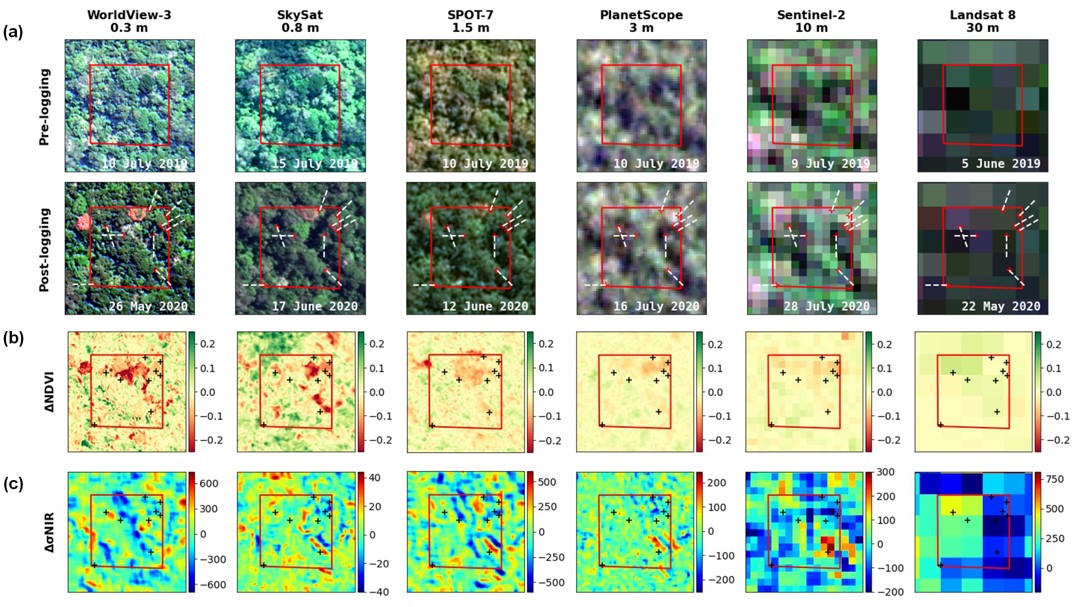Preprint
Article
Detecting Tropical Forest Degradation Using Optical Satellite Data: An Experiment in Peru Show Texture at 3 M Gives Best Results
Altmetrics
Downloads
340
Views
610
Comments
0
supplementary.zip (10.04MB )
Submitted:
01 February 2022
Posted:
09 February 2022
You are already at the latest version
Alerts
Abstract
Forest degradation is known to be widespread in the tropics, but is currently very poorly mapped, in part because there is little quantitative data on which satellite sensor characteristics and analysis methods are best at detecting it. To improve this, we used data from the Tropical Forest Degradation Experiment (FODEX) plots in the southern Peruvian Amazon, where different numbers of trees had been removed from four 1 ha forest plots, carefully inventoried by hand and Terrestrial Laser Scanning before and after the logging to give a range of biomass change (ΔAGB) values. We conducted a comparative study of six multispectral optical satellite sensors (WorldView-3, SkySat, SPOT-7, PlanetScope, Sentinel-2 and Landsat 8) at 0.3 – 30 m spatial resolution, to find the best combination of sensor and remote sensing indicator for change detection. Spectral reflectance, the Normalized Difference Vegetation Index (NDVI) and texture parameters were extracted after radiometric calibration and image preprocessing. The strength of the relationships between the change in these values and field-measured ΔAGB (computed in % ha−1) was analysed. The results demonstrate that: (a) texture measures correlates more with ΔAGB than simple spectral parameters; (b) the strongest correlations are achieved for those sensors with spatial resolutions in the intermediate range (1.5 - 10 m), with finer or coarser resolutions producing worse results, and (c) when texture is computed using a moving square window ranging between 9 - 14 m in length. Maps predicting ΔAGB showed very promising results using a NIR-derived texture parameter for 3 m resolution PlanetScope (R2 = 0.97 and RMSE = 1.80 % ha−1), followed by 1.5 m SPOT-7 (R2 = 0.74 and RMSE = 5.25 % ha−1) and 10 m Sentinel-2 (R2 = 0.71 and RMSE = 5.55 % ha−1). Texture models derived from 0.3 m WorldView-3 improved with increasing window size, with highest R2 of 0.62 and RMSE = 6.35 % ha−1 for a window of 14 m in length. The degradation in our field plots is invisible to the 30 m resolution Landsat data. Our findings imply that, at least for lowland Peru, low-medium intensity disturbance can be detected best in optical wavelengths using a texture measure derived from 3 m PlanetScope data. That such data are being collected daily, and currently released free as monthly mosaics over tropical forests as part of the Norway’s International Climate and Forest Initiative (NICFI), is excellent news for monitoring such degradation.

Keywords:
Subject: Environmental and Earth Sciences - Space and Planetary Science
Copyright: This open access article is published under a Creative Commons CC BY 4.0 license, which permit the free download, distribution, and reuse, provided that the author and preprint are cited in any reuse.
MDPI Initiatives
Important Links
© 2024 MDPI (Basel, Switzerland) unless otherwise stated








